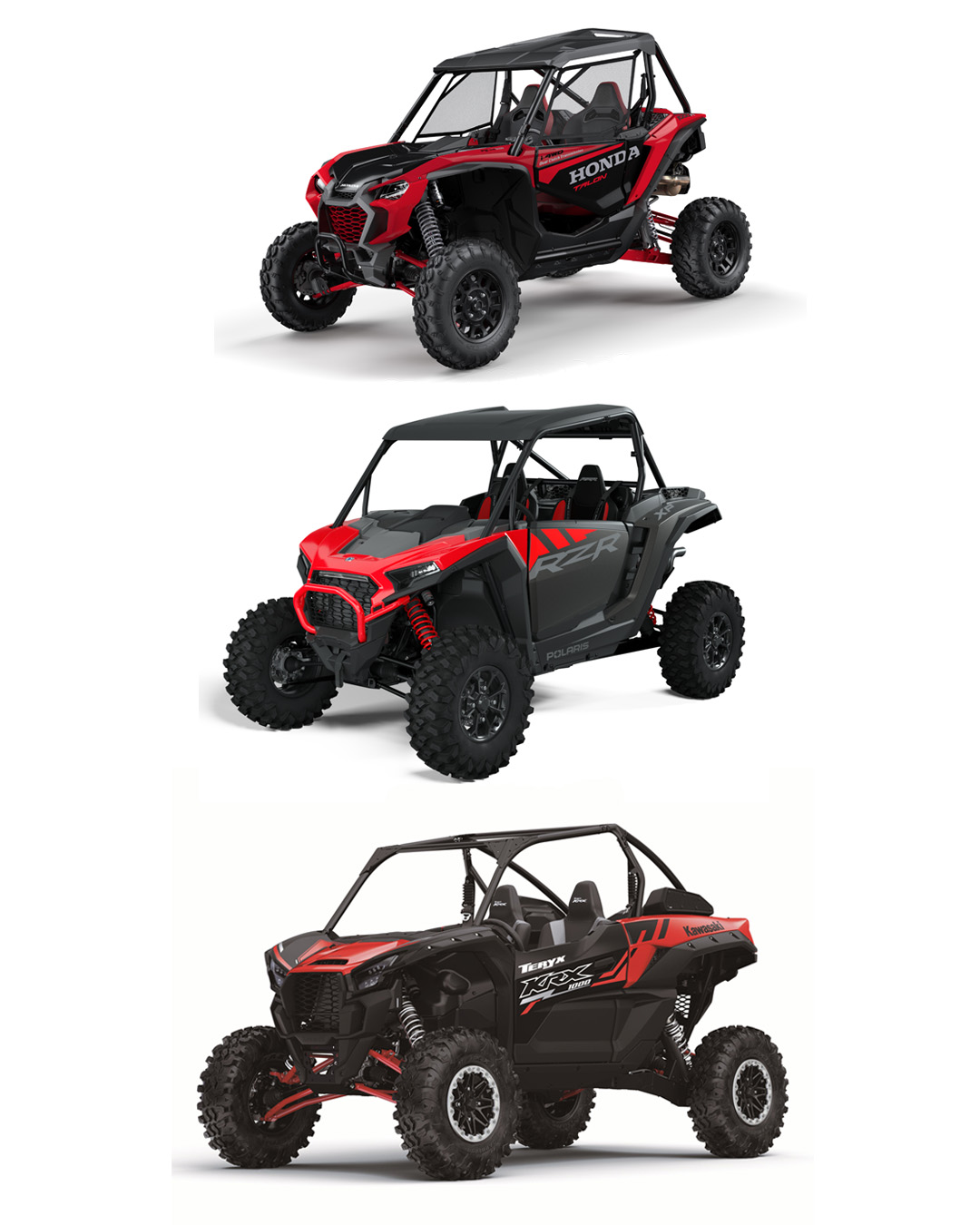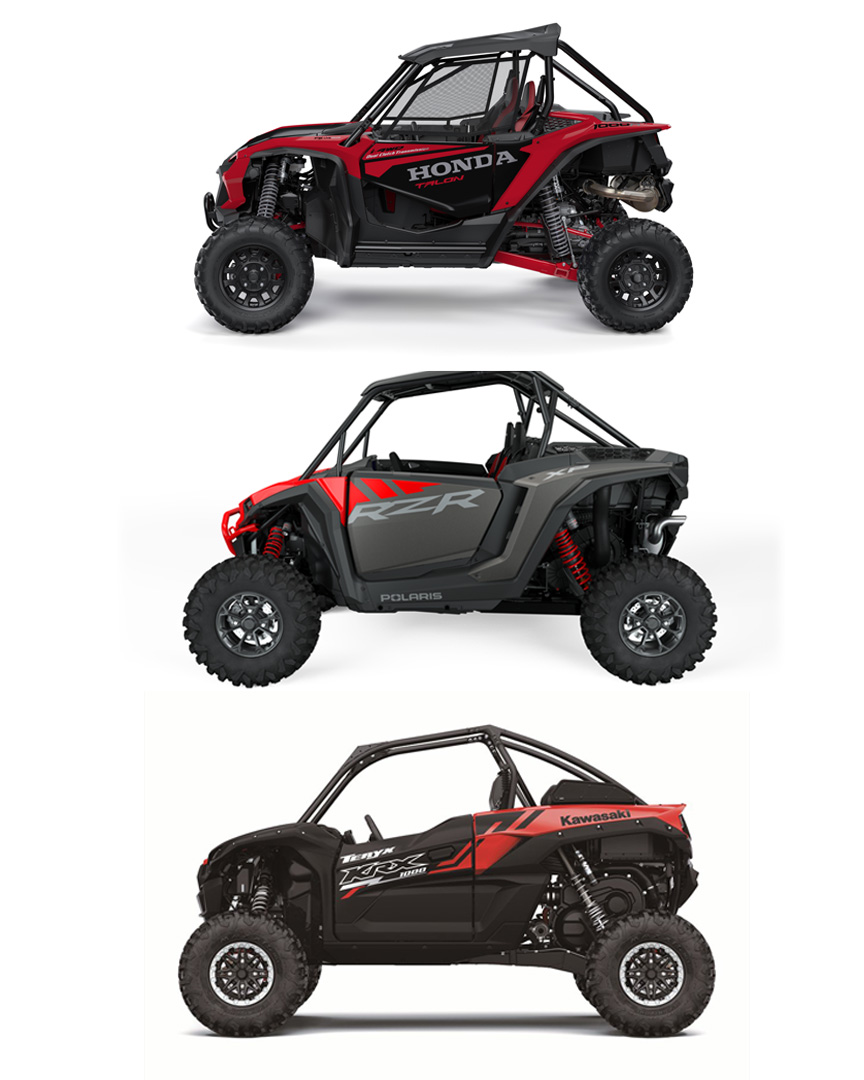There is no other sport UTV that has done more for the sport than the Polaris RZR XP. This is the first sport UTV to come with a 1,000-class engine, and the suspension, handling and
horsepower this legendary machine has produced over the years has basically helped create an entire market segment. For 2024, Polaris has developed an all-new RZR XP that now boasts a beefier frame, more power and more room in the cockpit. This begs the question – How will it stack up compared to some of the competition in the category, like Kawasaki’s awesome Teryx KRX 1000 and Honda’s amazing Talon 1000R? While we can’t give you impressions of the XP from behind the wheel just yet, we can take a look at all three, by the numbers, to show you how these machines all stack up on paper. Here’s our UTV Comparison between the New RZP XP vs KRX vs Talon.
New RZP XP vs KRX vs Talon
New RZP XP vs KRX vs Talon
Right off the bat, the new RZR XP comes out swinging with an all-new 999cc, Gen 2, ProStar twin-cylinder, liquid-cooled, four-stroke motor that produces 114 horsepower. Polaris is claiming quicker acceleration with this new motor, and have mated it to an all-new CVT transmission that is geared lower than previous RZR XP motors for smoother power that is more responsive to how you move your right foot. It also comes with a geared reverse gear for better response when you need to back it out of a tight spot. New air ducting is designed to make the CVT run
cooler, too.
Comparatively speaking, Kawasaki’s KRX uses an eight-valve, DOHC, 999cc, parallel twin
cylinder four stroke motor that pumps out an unofficial 112 horses. Like the RZR, this motor is mated to an CVT transmission with high and low range, and for those of you who have tried it out, you know that the KRX has tons of low-end power for crawling over tough trail obstacles.
Honda powers the Talon 1000R with a 999cc liquid-cooled Unicam, longitudinally-mounted,
parallel-twin, four-stroke motor that produces an also unofficial 105 horsepower. Unlike the
Polaris and Kawasaki machines, Honda does not use a CVT transmission, instead opting for
their sweet six-speed plus reverse Dual Clutch Transmission (DCT). With the Honda, you can opt for automatic mode, automatic Sport mode or manual mode for shifting. Auto and Sport modes shift for you at pre-mapped RPMs. The Sport mode doesn’t boost power, per say, instead it holds the shift longer, giving you more use of the building RPMs. Manual mode uses paddle shifters mounted to the steering column for a fun, hands-on driving experience. There are quite a few folks that say the Honda feels like it has more horsepower than it does, simply because there is no CVT lag to the transmission. We can’t wait to test these machines out head-to-head to see how it feels compared to the new RZR.
Suspension stuff
Polaris outfits the new RZR XP Sport with their tried and true Walker Evans Racing shocks. The front dual A-arm design uses 2-inch Walker Evans Needle shocks with 16-position adjustable clickers, a front sway bar and 20-inches of travel and 16 inches of usable wheel travel. Out back, 2.5-inch Walker Evans Needle shocks, also with 16-click adjustment, are mated to rear trailing arms that are also connected with a sway bar. The rear set-up also gives you 20 inches of travel, but usable wheel travel bumps up to 18 inches. The Premium and Ultimate versions of the RZR Xp bump up the shocks’ travel by an extra .5 inch at both ends, giving you a little better ride quality. This applies to both the two- and four-seat variations of the 2024 RZR.
Kawasaki outfits the KRX with a double wishbone system in the front with FOX 2.5 PODIUM
LSC shocks with piggyback reservoir. These shocks have fully adjustable preload and 24-
position adjustable compression damping with 18.6 inches of travel. In the back there is a 4-link trailing-arm rear suspension that uses FOX 2.5 PODIUM LSC shocks with a piggyback
reservoir. These shocks have fully adjustable preload and 24-position adjustable compression damping with 21.1 inches of travel. The eS edition KRX swaps in FOX 2.5 Podium Live Valve Internal Bypass shocks with a piggyback reservoir, adjustable preload, and KECS-controlled compression damping that adapts to your driving conditions and style. The same systems are used on the two- and four-seat KRX machines.
Honda rides in using FOX PODIUM piggyback shocks in an independent double-wishbone front system with 17.7 inches of travel. The rear system is a 4+ link trailing arm design and the shocks have 20.1 inches of travel. The Live Valve models use the FOX PODIUM Live Valve shocks mated to a cool Bosch controller that makes adjustments to the shock settings according to your conditions and driving style to the millisecond.
While Polaris hasn’t announced a live valve shock version for the 2024 RZR XP yet, you never know what they have up their sleeves.
Tires and clearance
Polaris is outfitting the 2024 RZR Xp with 30x10x14 radial TrailMaster X/T 2.0 tires mounted to aluminum wheels. Comparatively, Kawasaki outfits the KRX with 31x10x15 Maxxis Carnivore tires mounted on aluminum wheels. The Honda comes with the smallest stock tires, which are 28-inches tall. The front is a 9-inch width tire, while the rear is an 11. Both are mounted to 15-inch aluminum wheels. These tires match up with the machines to give you varied ground clearance. The Polaris comes in with 14.5 inches of ground clearance. The Kawasaki KRX tops this category with 15.2 inches of ground clearance, and the Honda Talon slides in with 12.7 inches of ground
clearance.
New RZP XP vs KRX vs Talon
Size matters
These aren’t exactly small machines, and you will notice that the category seems to be getting beefier. Polaris claims that the new XP has increased overall frame rigidity by 25%, and beefed up the driveline with stiffer half shafts, prop shafts and bearings, while adding beefier bumpers and a skid plate. The overall dimensions for the two-seat RZR XP Sport model are 119.4-inches long, by 64-inches wide by 71.1-inches tall. It has a 90-inch wheelbase and comes in at 1,574 pounds dry.
Anyone who has seen or driven a Kawasaki KRX knows that these machines are beasts. They are large and beefy, but don’t feel bulky when you drive them. The two-seat KRX is 130.1-inches long by 68.1-inches wide by 74.8-inches tall. It has a 98.8-inch wheelbase and is listed as having a curb weight of 1,896.3 pounds.
The Honda Talon 1000R two-seater rolls in being 123.7-inches long by 68.4-inches wide by
75.6-inches tall. This gives the 1000R a wheelbase of 92.7 inches. The Talon has a curb weight of 1,554 pounds, making it lighter, fully-loaded, than the new RZR, but bigger overall in size.
Fuel capacity varies. The RZR has a 9.5 gallon tank, which puts it right between the Talon’s
smaller 7.3 gallon (with 1.1 in reserve) and the KRX’s 10.6 gallon fuel tank. How fast you go through these fuel supplies, of course, depends mostly on how much you like to use your right foot. We like to use it a lot.
This and that
Like most new sport machines, all three come with LED lighting all around. Honda and Polaris both have improved their interior areas for the newest models, with the RZR boasting a bigger, more comfortable cockpit compared to the previous models, which were pretty comfy if you ask us. Honda also improved on their cockpit space to make it more user friendly and comfortable to the driver and passenger. Again, we liked the Honda interior before, and the newest model is even better. This is likely inspired by the KRX interior, which is, in our opinion, the most spacious of the sport UTVs.
Which machine is best for you?
Take a look at each of them and, even better, go to your local dealership and hop in them to see which one best fits you. If there is a demo day, then be sure to get behind the wheel and drive one. That is the best way to figure out how you should spend your money.
Speaking of money, the 2024 Polaris RZR XP starts at $20,999. The KRX starts out at $23,199 and the Talon 1000R starts out at $21,099. Of course, pricing varies by dealership, model, and accessory packages, too. Happy trails!




